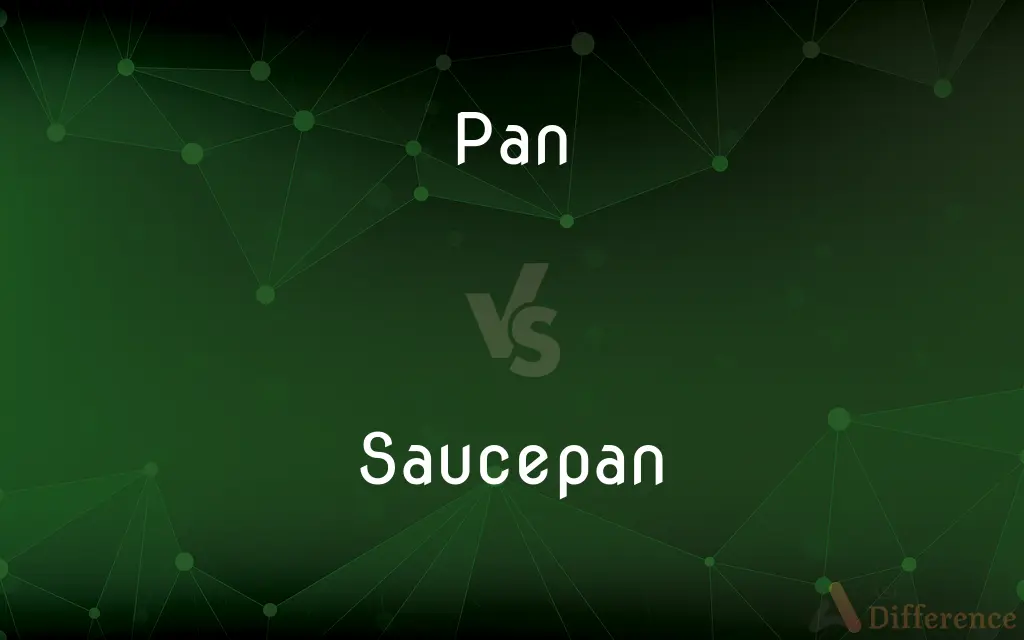Pan vs. Saucepan — What's the Difference?
Edited by Tayyaba Rehman — By Fiza Rafique — Updated on March 20, 2024
A pan is a broad term for various cooking vessels with low sides, ideal for frying and sautéing, whereas a saucepan is a type of pan with high, straight sides and a long handle, designed for liquids and sauces.

Difference Between Pan and Saucepan
Table of Contents
ADVERTISEMENT
Key Differences
Pans, in general, are versatile cooking utensils used across various cooking methods, including frying, grilling, and sautéing. They typically have shallow, sloped sides to facilitate easy flipping or removal of food, making them ideal for cooking items like eggs, pancakes, or meat. On the other hand, saucepans are specifically designed for cooking liquids or sauces. They have taller, straight sides that help prevent rapid liquid evaporation and splashing, suitable for boiling, simmering, or making soups.
The design of a pan, with its wide, open top and low sides, maximizes the surface area exposed to heat, allowing food to cook evenly and quickly. This design is particularly beneficial for achieving a good sear on meats or reducing sauces by evaporation. In contrast, the saucepan’s high sides and narrower opening concentrate heat, which is essential for tasks that require gentle, even cooking, such as making custards or cooking grains and pasta.
Material composition varies widely among pans and saucepans, with each designed to suit their cooking purposes. Pans often come in materials conducive to high heat and quick cooking, such as cast iron or stainless steel, while saucepans may also include materials like aluminum or copper, known for their excellent heat conductivity, ensuring even cooking of liquids without hot spots.
In terms of usage, pans are a kitchen staple for searing, browning, and quick cooking, making them indispensable for everyday meals. Saucepans, with their specific design, are essential for recipes requiring controlled simmering or boiling, such as sauces, stews, and porridges, offering a specialized tool for more liquid-based cooking.
The choice between a pan and a saucepan often depends on the cooking task at hand. For high-heat, fast-cooking methods, or when cooking items that need to be flipped or stirred frequently, a pan is the preferred choice. Conversely, for tasks that involve liquids or require slow, even heat, a saucepan is more appropriate, reflecting the specialized nature of these two essential kitchen tools.
ADVERTISEMENT
Comparison Chart
Sides
Low, often sloped
High, straight
Ideal Use
Frying, sautéing, grilling
Boiling, simmering, making sauces
Heat Distribution
Designed for quick, even heating
Designed to prevent liquid evaporation, even heating
Materials
Cast iron, stainless steel, non-stick
Aluminum, stainless steel, copper
Cooking Methods
Searing, browning, reducing sauces
Cooking grains, pasta, custards
Compare with Definitions
Pan
Ideal for quick cooking and flipping foods.
The chef flipped pancakes easily in the lightweight pan.
Saucepan
Designed for cooking liquids and sauces.
I simmered the tomato sauce in a saucepan for two hours.
Pan
Commonly made from materials like cast iron.
The cast iron pan is perfect for searing steak.
Saucepan
Often made with copper for even heat.
The copper saucepan evenly heated the custard without burning.
Pan
Used for searing and browning meats.
For a perfect crust, sear the meat in a hot pan.
Saucepan
Essential for boiling and simmering.
Use a saucepan to boil water for pasta or rice.
Pan
Features low, sloped sides.
The pan's design made sliding the omelet onto a plate effortless.
Saucepan
Features high, straight sides.
The saucepan's tall sides prevented the soup from splashing.
Pan
A versatile cooking vessel for high-heat methods.
I used a non-stick pan to fry the eggs.
Saucepan
Suitable for making stews and porridges.
The stew cooked slowly in the saucepan, absorbing all the flavors.
Pan
A god of flocks and herds, typically represented with the horns, ears, and legs of a goat on a man's body. His sudden appearance was supposed to cause terror similar to that of a frightened and stampeding herd, and the word panic is derived from his name.
Saucepan
A deep cooking pan with a handle.
Pan
Criticize severely
The movie was panned by the critics
Saucepan
A deep cooking vessel with a handle and sometimes a lid; used for boiling, stewing and making sauces.
Pan
Wash gravel in a pan to separate out (gold)
Prospectors panned for gold in the Yukon
The old-timers panned gold
Saucepan
To cook in a saucepan
Pan
Swing (a video or film camera) in a horizontal or vertical plane, typically to give a panoramic effect or follow a subject
He was panning the camera over everything in sight
Saucepan
A small pan with a handle, in which sauce is prepared over a fire; a stewpan.
Pan
A shallow, wide, open container, usually of metal and without a lid, used for holding liquids, cooking, and other domestic purposes.
Saucepan
A deep pan with a handle; used for stewing or boiling
Pan
An open metal dish used to separate gold, other precious metals, or gemstones from gravel or waste by washing.
Pan
Either of the receptacles on a balance or pair of scales.
Pan
A vessel used for boiling and evaporating liquids.
Pan
A basin or depression in the earth, often containing mud or water.
Pan
A natural or artificial basin used to obtain salt by evaporating brine.
Pan
Hardpan.
Pan
A freely floating piece of ice that has broken off a larger floe.
Pan
The small cavity in the lock of a flintlock used to hold powder.
Pan
(Music) A steel drum.
Pan
(Slang) The face.
Pan
(Informal) Severe criticism, especially a negative review
Gave the film a pan.
Pan
Variant of paan.
Pan
A pivoting movement of a movie camera.
Pan
Peroxyacetyl nitrate
Pan
Greek Mythology The god of woods, fields, and flocks, having a human torso and head with a goat's legs, horns, and ears.
Pan
To wash (gravel, for example) in a pan to separate out gold, other precious metals, or gemstones.
Pan
To cook (food) in a pan
Panned the fish right after catching it.
Pan
(Informal) To criticize or review harshly.
Pan
To wash gravel, sand, or other sediment in a pan.
Pan
To yield gold as a result of washing in a pan.
Pan
To pivot a movie camera along a horizontal plane in order to follow an object or create a panoramic effect.
Pan
To pivot (a movie camera) in a specified direction.
Pan
A wide, flat receptacle used around the house, especially for cooking.
Pan
The contents of such a receptacle.
Pan
A cylindrical receptacle about as tall as it is wide, with one long handle, usually made of metal, used for cooking in the home.
Pan
(Ireland) A deep plastic receptacle, used for washing or food preparation; a basin.
Pan
A wide receptacle in which gold grains are separated from gravel by washing the contents with water.
Pan
An expanse of level land located in a depression, especially
Pan
A pond or lake, considered as the expanse of land upon which the water sits.
Pan
A dry lake or playa, especially a salt flat.
Pan
(South Africa) playa lake: a temporary pond or lake in a playa.
Pan
: a flat artificial pond used for collecting minerals from evaporated water.
Pan
(geology) nodot=a: a hard substrate such as is formed in pans.
Pan
Syn of pipe: a channel for lava within a volcano; the cylindrical remains of such channels.
Pan
Strong adverse criticism.
Pan
A loaf of bread.
Pan
The chamber pot in a close stool; the base of a toilet, consisting of the bowl and its support.
Pan
(slang) A human face, a mug.
Pan
(roofing) The bottom flat part of a roofing panel that is between the ribs of the panel.
Pan
A closed vessel for boiling or evaporating as part of manufacture; a vacuum pan.
Pan
(firearms) The part of a flintlock that holds the priming.
Flash in the pan
Pan
The skull, considered as a vessel containing the brain; the brainpan.
Pan
(figurative) The brain, seen as one's intellect.
Pan
(carpentry) A recess, or bed, for the leaf of a hinge.
Pan
(musical instrument) steelpan
Pan
A part; a portion.
Pan
(fortifications) The distance comprised between the angle of the epaule and the flanked angle.
Pan
A leaf of gold or silver.
Pan
(transitive) To wash in a pan (of earth, sand etc. when searching for gold).
Pan
(transitive) To disparage; to belittle; to put down; to harshly criticize, especially a work (book, movie, etc.)
Pan
To turn out well; to be successful.
Pan
To beat one's opposition convincingly.
Pan
To turn horizontally.
Pan
To move the camera lens angle while continuing to expose the film, enabling a contiguous view and enrichment of context. In still-photography large-group portraits the film usually remains on a horizontal fixed plane as the lens and/or the film holder moves to expose the film laterally. The resulting image may extend a short distance laterally or as great as 360 degrees from the point where the film first began to be exposed.
Pan
To shift an image relative to the display window without changing the viewing scale.
Pan
(audio) To spread a sound signal into a new stereo or multichannel sound field, typically giving the impression that it is moving across the sound stage.
Pan
To join or fit together; to unite.
Pan
A part; a portion.
Pan
The distance comprised between the angle of the epaule and the flanked angle.
Pan
A leaf of gold or silver.
Pan
The betel leaf; also, the masticatory made of the betel leaf, etc. See Betel.
Pan
A shallow, open dish or vessel, usually of metal, employed for many domestic uses, as for setting milk for cream, for frying or baking food, etc.; also employed for various uses in manufacturing.
Pan
A closed vessel for boiling or evaporating. See Vacuum pan, under Vacuum.
Pan
The part of a flintlock which holds the priming.
Pan
The skull, considered as a vessel containing the brain; the upper part of the head; the brainpan; the cranium.
Pan
A recess, or bed, for the leaf of a hinge.
Pan
The hard stratum of earth that lies below the soil. See Hard pan, under Hard.
Pan
A natural basin, containing salt or fresh water, or mud.
Pan
To join or fit together; to unite.
Pan
To separate, as gold, from dirt or sand, by washing in a kind of pan.
We . . . witnessed the process of cleaning up and panning out, which is the last process of separating the pure gold from the fine dirt and black sand.
Pan
To criticise (a drama or literary work) harshly.
Pan
To yield gold in, or as in, the process of panning; - usually with out; as, the gravel panned out richly.
Pan
To turn out (profitably or unprofitably); to result; to develop; as, the investigation, or the speculation, panned out poorly.
Pan
To scan (a movie camera), usu. in a horizontal direction, to obtain a panoramic effect; also, to move the camera so as to keep the subject in view.
Pan
The god of shepherds, guardian of bees, and patron of fishing and hunting. He is usually represented as having the head and trunk of a man, with the legs, horns, and tail of a goat, and as playing on the shepherd's pipe (also called the pipes of Pan), which he is said to have invented.
Pan
Cooking utensil consisting of a wide metal vessel
Pan
(Greek mythology) god of fields and woods and shepherds and flocks; represented as a man with goat's legs and horns and ears; identified with Roman Sylvanus or Faunus
Pan
Shallow container made of metal
Pan
Chimpanzees; more closely related to Australopithecus than to other pongids
Pan
Make a sweeping movement;
The camera panned across the room
Pan
Wash dirt in a pan to separate out the precious minerals
Pan
Express a totally negative opinion of;
The critics panned the performance
Common Curiosities
What is the main difference between a pan and a saucepan?
The main difference lies in their design; pans have low, sloped sides for easy food flipping, while saucepans have high, straight sides for liquid-based cooking.
What kind of pan is best for frying?
A skillet or frying pan with low, slightly sloped sides is best for frying, allowing easy access to the food.
Can you use a pan instead of a saucepan?
While you can use a pan for some saucepan tasks, it's not ideal for cooking liquids due to its shallow sides.
Is a saucepan good for making rice?
Yes, a saucepan is ideal for making rice due to its high sides and even heat distribution, perfect for simmering and absorption cooking methods.
How do you choose between a pan and a saucepan?
Choose based on the cooking method; pans are better for high-heat, fast-cooking tasks, while saucepans are suited for liquid-based cooking and simmering.
Why do saucepans have long handles?
Saucepans have long handles to provide stability and ease of handling when dealing with hot liquids.
What size saucepan is most versatile?
A 2- to 3-quart saucepan is versatile enough for most cooking needs, from boiling eggs to making sauces.
How do material differences affect cooking in pans vs. saucepans?
Material affects heat conductivity and retention; pans often use materials that withstand high heat, while saucepans use materials for even, gentle cooking.
Can a saucepan be used in the oven?
Many saucepans are oven-safe, but always check the manufacturer's guidelines regarding temperature limits and handle material.
What maintenance is required for cast iron pans?
Cast iron pans require seasoning to maintain their non-stick surface and should be cleaned with minimal soap and water to prevent rust.
Share Your Discovery

Previous Comparison
Devil vs. God
Next Comparison
Hoot vs. SootAuthor Spotlight
Written by
Fiza RafiqueFiza Rafique is a skilled content writer at AskDifference.com, where she meticulously refines and enhances written pieces. Drawing from her vast editorial expertise, Fiza ensures clarity, accuracy, and precision in every article. Passionate about language, she continually seeks to elevate the quality of content for readers worldwide.
Edited by
Tayyaba RehmanTayyaba Rehman is a distinguished writer, currently serving as a primary contributor to askdifference.com. As a researcher in semantics and etymology, Tayyaba's passion for the complexity of languages and their distinctions has found a perfect home on the platform. Tayyaba delves into the intricacies of language, distinguishing between commonly confused words and phrases, thereby providing clarity for readers worldwide.














































